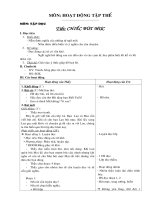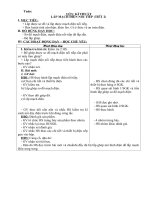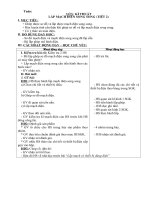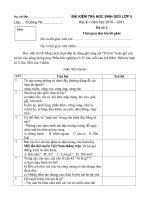- Trang chủ >>
- Mầm non - Tiểu học >>
- Lớp 5
5 2 5 paul reveres midnight ride
Bạn đang xem bản rút gọn của tài liệu. Xem và tải ngay bản đầy đủ của tài liệu tại đây (2.77 MB, 12 trang )
Suggested levels for Guided Reading, DRA,™
Lexile,® and Reading Recovery™ are provided
in the Pearson Scott Foresman Leveling Guide.
Paul Revere’s
Midnight Ride
Genre
Narrative
nonfiction
Comprehension
Skills and Strategy
• Sequence
• Draw Conclusions
• Ask Questions
Text Features
• Labels
• Map
• Glossary
Scott Foresman Reading Street 5.2.5
ISBN 0-328-13529-1
ì<(sk$m)=bdfcjf< +^-Ä-U-Ä-U
by Stephanie Wilder
illustrated by Phyllis Pollema-Cahill
Reader
Response
Paul Revere’s
Midnight Ride
1. Fill in a chart like the one below to show the sequence
of Paul Revere’s actions after he alerted Adams and
Hancock.
by
Stephanie Wilder
illustrated
by Phyllis Pollema-Cahill
First
Next
Last
2. Think of two questions you would like to have
answered based on what you just read. Where could
you find answers to your questions?
3. Look at the word fearless in the glossary. It means
“without fear.” Think of two more words that end in
the suffix -less. What do those words mean? Use each
word in a sentence.
4. Information in nonfiction books can come from
both words and pictures. Turn to page 10 and tell
something that you learned from the picture.
Editorial Offices: Glenview, Illinois • Parsippany, New Jersey • New York, New York
Sales Offices: Needham, Massachusetts • Duluth, Georgia • Glenview, Illinois
Coppell, Texas • Ontario, California • Mesa, Arizona
On a chilly April night in 1775, Paul Revere found
himself in a small rowboat facing the deep dark of night.
Revere was not afraid. He knew that the message he
carried had to reach Lexington before sunrise. The freedom
of the colonies rested in Revere’s hands. Nothing would stop
him from getting his job done.
Every effort has been made to secure permission and provide appropriate credit for
photographic material. The publisher deeply regrets any omission and pledges to
correct errors called to its attention in subsequent editions.
Unless otherwise acknowledged, all photographs are the property of Scott Foresman,
a division of Pearson Education.
Photo locators denoted as follows: Top (T), Center (C), Bottom (B), Left (L), Right (R),
Background (Bkgd)
Illustrations by Phyllis Pollema-Cahill
ISBN: 0-328-13529-1
Copyright © Pearson Education, Inc.
All Rights Reserved. Printed in the United States of America. This publication is
protected by Copyright, and permission should be obtained from the publisher
prior to any prohibited reproduction, storage in a retrieval system, or transmission
in any form by any means, electronic, mechanical, photocopying, recording, or
likewise. For information regarding permission(s), write to: Permissions Department,
Scott Foresman, 1900 East Lake Avenue, Glenview, Illinois 60025.
2 3 4 5 6 7 8 9 10 V0G1 14 13 12 11 10 09 08 07 06 05
3
Earlier that night, Revere’s friend Robert Newman had
put two lanterns in the bell tower of the Old North Church
in Boston. The lanterns would glow in the night sky as a
warning to the Sons of Liberty.
The Sons of Liberty was a group that wanted to lead
the colonies away from British rule. The two lanterns told
them that British soldiers were on their way to Lexington by
sea. If Newman had put only one lantern in the bell tower,
it would have meant that the British were coming by land.
The water route was faster, so Revere would have to work
quickly.
4
5
When Revere arrived on the other side of the river, he
met with his good friend Deacon Larkin. The deacon was
waiting with a strong steed to take Revere through the
countryside.
Revere climbed onto the horse and set off quickly into
the dark night. The journey was long and hard. Revere
had trouble seeing where he was going. The darkness
magnified his fear that he might run into British soldiers,
who would surely try to stop him.
Revere was brave, though. He would not let his fears
keep him from warning all the people who lived in the
villages that the British soldiers were coming.
In case the Sons of Liberty had not seen the glimmer
of the lanterns, Revere needed to go to Lexington in person
to tell Samuel Adams and John Hancock the message.
Hancock and Adams were leaders of the Sons of Liberty.
Revere wanted to warn them that the British army was
coming to arrest them. He also wanted to tell them that the
British planned to march on to Concord after stopping in
Lexington. The colonial militia, or army, needed to stop
them to save the weapons and supplies stored in Concord.
6
7
While Revere was busy making his way to Lexington,
the British were busy with their march too. The British
troops made their way northwest through the town of
Menotomy, which is now called Arlington.
At the same time, another rider named William Dawes
was traveling to Lexington with the same message that
Revere carried. The two were riding along different roads in
case one was stopped by the British.
8
Just after midnight, both Revere and Dawes arrived
safely in Lexington. Revere went straight to the house of
Reverend Clark, where Adams and Hancock were staying.
As Revere rode along the path to the house to warn
Adams and Hancock, his horse made too much noise, and
a colonial guard told him to be quiet. Revere was angry
at this and said, “Noise! You’ll have noise enough before
long.” If the British troops were not stopped by the militia in
Lexington, there would certainly be more noise when they
reached Concord and fought a bigger battle there.
9
Revere woke Adams and Hancock and told them about
the British. Hearing the news, the two men planned to
return to Boston within a few hours.
Then Revere met with William Dawes to decide what to
do next. They both would ride on to Concord. There they
would be able to help in the fight against the British.
Along the way, Revere and Dawes met Dr. Samuel
Prescott. Dr. Prescott joined them, and the three men rode
on together.
10
At two o’clock that morning, Revere’s biggest worry
came true. He and his friends were stopped by British
soldiers who were keeping watch over the roads. Dawes and
Dr. Prescott were able to get away, but Revere was taken
prisoner. The fearless Revere would not be held for long,
though. He soon began to think of a plan to get away from
the British.
11
The British soldiers asked Revere many questions, but
he was very smart. He told them that the British troops
would face a battle at Lexington and that they should flee
for their lives. The soldiers took Deacon Larkin’s horse and
gave Revere one of their tired ones. They let Revere go, and
he set out again into the dark night alone.
Revere had been on his way to Concord. But now that
his strong horse had been taken from him, he decided to
head back to Lexington to see if his friends were still there.
He reached Reverend Clark’s house at three o’clock in the
morning, and Adams and Hancock were just preparing to
leave. Together the three men made a quick escape.
12
13
As they climbed into a stagecoach, Hancock
remembered something important. He’d forgotten his trunk
at Buckman’s Tavern, where he and Adams had stopped
earlier that night. The trunk contained important documents
that he did not want the British to see. Revere volunteered
to retrieve the trunk and told his friends to go on ahead.
14
It was four-thirty in the morning when he reached the
tavern and found the trunk. He was tired and hungry,
but he was happy that he had done his part to warn the
colonies’ leaders. He was relieved that Adams and Hancock
were safe and that the trunk was safely in his own hands.
Would he make it, though, to fight in the battle that was
about to start?
15
As dawn broke on Lexington Green, the colonial militia
lined up to meet the British army. The colonists had only
seventy-seven fighting men at Lexington. They would face
several hundred British soldiers. The militiamen believed
in the colonies’ right to rule themselves as much as Revere
and the Sons of Liberty did. They stood bravely on the field
and awaited their fate. It would be the first battle of the
American Revolution.
On that somber morning in 1775, the colonial militia
faced the well-trained British army. Revere listened from
a distance as the “shot heard round the world” was fired.
The battle for the colonies had begun. The colonists were
outnumbered by the British and were forced to retreat. Eight
militiamen lost their lives as the British pushed through
Lexington Green and on toward Concord.
16
17
Later that morning, the British arrived in Concord. But
when they got there, they found more than three times as
many militiamen as they had faced at Lexington. The fight
would not be won as easily this time. The colonists were
able to force the British troops back to Boston. They saved
their supply of weapons and took an important first step
toward freedom.
Paul Revere did not fight in the Battles of Lexington
and Concord on that April morning, but he did play a big
role. His legend lingers in history and is a story that makes
Americans feel proud. If he had not braved the dark of night
and warned the people of the British attack, the colonists
would not have been ready for the fight.
18
19
Reader Response
Glossary
fate n. things that happen
to people that cannot be
controlled.
fearless adj. brave;
without fear.
glimmer n. a faint,
unsteady light.
lingers v. stays.
magnified v. increased.
somber adj. serious.
steed n. a lively horse.
1. Fill in a chart like the one below to show the sequence
of Paul Revere’s actions after he alerted Adams and
Hancock.
First
Next
Last
2. Think of two questions you would like to have
answered based on what you just read. Where could
you find answers to your questions?
3. Look at the word fearless in the glossary. It means
“without fear.” Think of two more words that end in
the suffix -less. What do those words mean? Use each
word in a sentence.
4. Information in nonfiction books can come from
both words and pictures. Turn to page 10 and tell
something that you learned from the picture.
20









